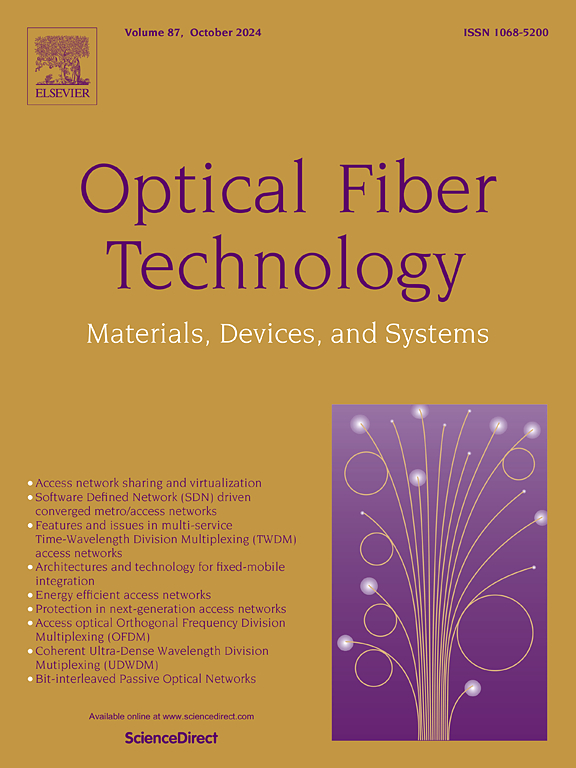使用基于匹配干涉测量的优化 SVMD 的抗噪 UWFBG 水听器阵列增强型 DAS 系统
IF 2.6
3区 计算机科学
Q2 ENGINEERING, ELECTRICAL & ELECTRONIC
引用次数: 0
摘要
针对高性能干涉光纤水听器传感系统中的超弱光纤布拉格光栅(UWFBG)背景噪声问题,本文提出了一种 RIME 优化算法与连续变模分解(RIME-SVMD)算法相结合的方法,以缓解 3 × 3 解调过程中由光源和其他非理想光传输引起的具有时变频率成分的非稳态噪声信号。SVMD 算法采用迭代法将解调信号分解为多个本征模式函数(IMF)分量。值得注意的是,与传统的 VMD 算法相比,SVMD 算法只需较少的参数而无需选择模数,但它通过 RIME 算法对优化目标进行改进,使模态分量的相位置换熵(PPE)均值最小化,从而实现参数的自适应选择。所提出的算法被应用于水下声学的自适应分解,从而得到多个 IMF 分量。具有最大相关系数标准的 IMF 被保留用于信号重建,其中包含大量水下声学特征信息。实验和比较结果表明,所提出的算法在有效去除系统和环境噪声的同时,还能保留水下声学信息,性能卓越。此外,与 VMD 相比,声学信号的信噪比(SNR)提高了 6.42 dB。此外,通过噪声抑制前后阵列信号波束成形的信息处理过程,我们注意到该方法能够实现 UWFBG 水听器阵列的定向探测,其方位角清晰,短时间内的变化更小。本文章由计算机程序翻译,如有差异,请以英文原文为准。
Anti-noise UWFBG hydrophone array enhanced DAS system using optimising SVMD based on matched interferometric
To address the problem of the ultra-weak fiber Bragg grating (UWFBG) background noise in the high-performance interferometric fiber-optic hydrophone sensing system, this paper proposed a combination of RIME optimization algorithm and successive variational mode decomposition (RIME-SVMD) algorithm to mitigate the non-stationary noise signal with time-varying frequency components, which induced by light source and other non-ideal optical transmissions during 3 × 3 demodulation. The SVMD algorithm adopts an iterative approach to decompose the demodulation signal into several Intrinsic Mode Function (IMF) components. Althouth it is worth noting that SVMD algorithm entail a fewer parameter without selecting the number of modes compared to traditional VMD algorithms, it is improved by RIME algorithm to establish the optimization objective, whose phase permutation entropy (PPE) mean of the modal components get minimized to realize the self-adaptive selection of parameters. The proposed algorithm is applied to the adaptive decomposition of the underwater acoustic, resulting in multiple IMF components. The IMFs with the maximum correlation coefficient criterion are retained for signal reconstruction, which contain a significant amount of underwater acoustic characterisation information. The experimental and comparative results show the exceptional performance of the proposed algorithm in effectively removing system and environmental noise while preserving underwater acoustic information. Furthermore, the signal-to-noise ratio (SNR) of the acoustic signal is improved by 6.42 dB compared to VMD. Furthermore, through the information process of beamforming the array signals before and after noise suppression, we note that the approach is capable of achieving directional detection by the UWFBG hydrophone array, which shows a clear azimuth with much less variation over short periods of time.
求助全文
通过发布文献求助,成功后即可免费获取论文全文。
去求助
来源期刊

Optical Fiber Technology
工程技术-电信学
CiteScore
4.80
自引率
11.10%
发文量
327
审稿时长
63 days
期刊介绍:
Innovations in optical fiber technology are revolutionizing world communications. Newly developed fiber amplifiers allow for direct transmission of high-speed signals over transcontinental distances without the need for electronic regeneration. Optical fibers find new applications in data processing. The impact of fiber materials, devices, and systems on communications in the coming decades will create an abundance of primary literature and the need for up-to-date reviews.
Optical Fiber Technology: Materials, Devices, and Systems is a new cutting-edge journal designed to fill a need in this rapidly evolving field for speedy publication of regular length papers. Both theoretical and experimental papers on fiber materials, devices, and system performance evaluation and measurements are eligible, with emphasis on practical applications.
 求助内容:
求助内容: 应助结果提醒方式:
应助结果提醒方式:


